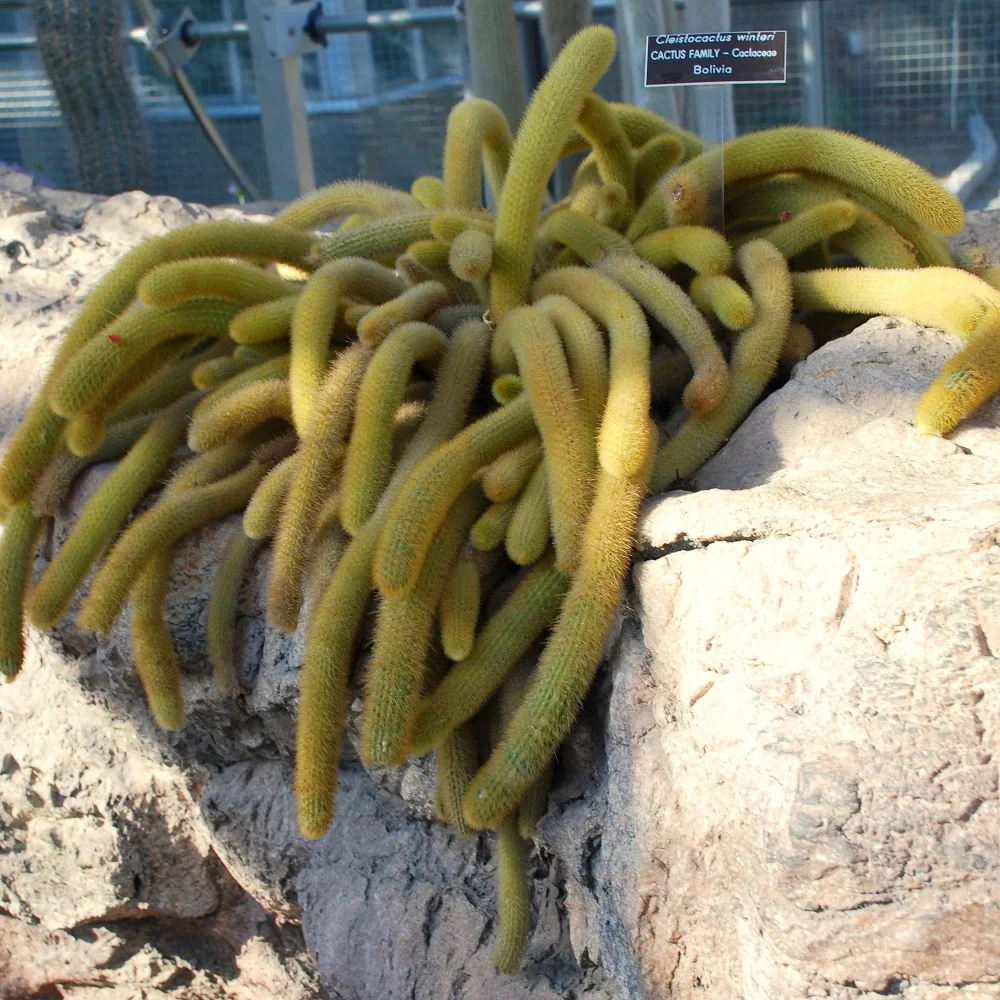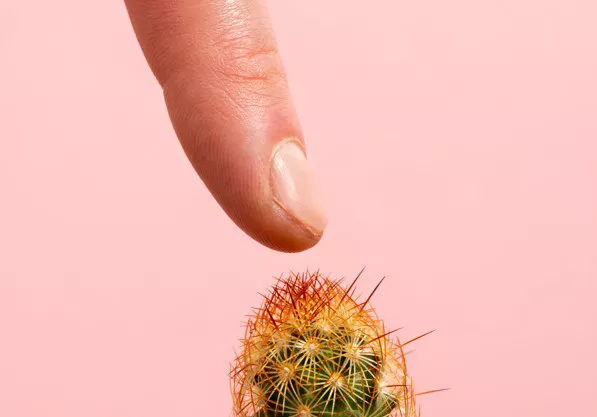Rat Tail Cacti encompass a variety of intriguing types, each with unique characteristics and care needs. From the classic green stems of the traditional Rat Tail Cactus to the vibrant red blooms of the Disocactus fulgens and the striking variegation of the Disocactus flagelliformis ‘Kimnach’, this post will explore these diverse varieties and their specific care requirements.
General Characteristics of Rat Tail Cactus
The Rat Tail Cactus (Aporocactus flagelliformis) is renowned for its distinctive trailing stems that can grow up to several feet long, covered in numerous short, fine spines, giving it a hairy appearance (1).
The stems are typically green but may turn a reddish hue with prolonged sun exposure. This cactus produces vibrant, tubular flowers in shades of pink or red, adding to its ornamental appeal.
Native to the mountainous regions of Mexico and Central America, the Rat Tail Cactus thrives in rocky, arid environments. It grows epiphytically, often found clinging to trees or rocks, showcasing its adaptability to different substrates and its preference for well-drained conditions.
Here’s a summary of Rat Tail Cactus features:
| Stem Characteristics | Trailing stems up to several feet long, covered in short, fine spines; green, turning reddish with sun exposure. |
| Flowers | Vibrant, tubular flowers in shades of pink or red, typically blooming in spring and summer. |
| Native Habitat | Mountainous regions of Mexico and Central America. |
| Soil Requirements | Well-draining cactus or succulent soil mix with 2 parts cactus soil, 1 part sand, and 1 part perlite or pumice. |
| Humidity Preferences | Prefers low to moderate humidity, around 40-60%. |
| pH Level | Prefers slightly acidic to neutral soil with a pH level of 6.0-7.0. |
| Light Requirements | Prefers bright, indirect light; can tolerate some direct sunlight but should be protected from intense midday sun. |
| Watering | Water thoroughly when the soil is dry; reduce watering in fall and winter. |
| Temperature Tolerance | Thrives in temperatures between 10-30°C (50-86°F); protect from frost and extreme heat. |
Types of Rat Tail Cactus
The name “Rat Tail Cactus” refers to several cacti species with long, slender, and trailing stems that resemble a rat’s tail. This type of cactus can be divided into the following three categories:
- Traditional Rat Tail Cactus
- Varieties with Different Colored Flowers
- Variegated Varieties
Here’s a breakdown of the three different types of Rat Tail Cactus:
Traditional Rat Tail Cactus (Disocactus flagelliformis)
This is the most common type of Rat Tail Cactus. It has long, green stems that can grow up to several feet long. The stems have few spines and produce small, pink flowers in the spring and summer.
They are epiphytic cacti, meaning they grow on other plants in the wild. They can be grown in hanging baskets or allowed to trail over pot edges.
Varieties with Different Colored Flowers
While the classic pink flowers of the Disocactus flagelliformis are undeniably charming, the world of Rat Tail Cactus offers a surprising range of colors beyond that. Here are some captivating varieties that bloom in hues other than pink:
1. Disocactus fulgens (Red Rat Tail Cactus):
- Distinguishing Feature: This variety boasts vibrant red flowers that will grab attention. The flowers are similar in size and shape to the classic pink blooms, but their fiery red adds drama and boldness.
- Blooming Time: Disocactus fulgens blooms in late spring and summer, adding a burst of color during the warmer months.
2. Disocactus spectabilis (Orange Rat Tail Cactus):
- Distinguishing Feature: This variety brings a touch of sunshine with its stunning orange flowers. The blooms are similar in size and shape to the classic pink ones, but their vibrant orange hue adds a cheerful and energetic vibe.
- Blooming Time: Disocactus spectabilis blooms in late spring or early summer, offering a vibrant display of color at the beginning of the warm season.
3. Other Potential Varieties:
While less common, there might be other Rat Tail Cactus varieties with flower colors outside the pink spectrum. These may include variations of red and orange or even rarer shades. Talking to experienced cactus growers or browsing specialized nurseries can help you discover these unique options.
Variegated Varieties
In Rat Tail Cactus, variegation typically manifests as stripes or patches of creamy white, yellow, or even gold, interrupting the usual green color of the stems. This variegation adds a touch of elegance and visual interest to the cactus.
- Disocactus flagelliformis ‘Kimnach’: This is perhaps the most well-known variegated Rat Tail Cactus. Its slender stems boast a beautiful combination of green and creamy-yellow variegation, creating a stunning contrast.
Growing Requirements for Different Types of Rat Tail Cactus
While all Rat Tail Cactus share some basic needs, there might be slight variations in their preferences depending on the specific variety. Here’s a breakdown of key considerations:
| Variety | Light | Temperature | Soil |
| Aporocactus flagelliformis (Common) | Bright, Indirect Sunlight (Full Sun to Partial Shade) | 60-80°F (15-27°C) | Well-draining cactus mix or regular potting soil with added sand/perlite |
| Cleistocactus winteri (Golden) | Full Sun | 60-75°F (15-24°C) | Well-draining cactus mix or regular potting soil with added sand/perlite |
| Disocactus flagelliformis (Red) | Bright, Indirect Sunlight (Some Direct Sunlight Okay) | 60-75°F (15-24°C) | Well-draining cactus mix or succulent soil mix |
What is Golden Rat Tail?
Cleistocactus winteri, commonly known as the Golden Rat Tail Cactus, is often included in conversations about rat tail types, even though it’s technically a different genus.
- Common Name: Golden Rat Tail
- Stems: Long, slender, and covered with soft golden spines — giving it a fuzzy, golden appearance
- Growth Habit: Trailing or cascading, up to 3+ feet long
- Flowers: Bright orange to salmon-pink blooms, tubular and vibrant
- Origin: Native to Bolivia
- Care: Loves bright light, well-draining soil, and occasional watering

Techniques for Propagating Different Types of Rat Tail Cactus
The beauty of Rat Tail Cactus is that they can be easily propagated, allowing you to multiply your collection or share the joy with friends. Here’s a breakdown of techniques and best practices for successful propagation:
There are two main methods for propagating Rat Tail Cactus, regardless of the specific variety:
Method 1-Stem Cuttings: This is the most common and successful method.
- Choose a healthy, mature stem segment with a few nodes (bumps where leaves or new growth emerge).
- Make a clean cut just below a node using a sterilized knife or pruning shears.
- Allow the cut end to callous over for several days. This drying period helps prevent rot.
- Plant the calloused cutting in a well-draining cactus mix, burying the node slightly.
- Water sparingly to encourage root development.
Method 2-Seeds (Less Common): Propagating through seeds is less common as it takes longer for the seedlings to mature. However, it can be a rewarding experience for patient growers.
- If you can find Rat Tail Cactus seeds, follow the specific germination instructions provided by the supplier. These may involve soaking the seeds before planting.
- Sow the seeds in a well-draining cactus mix and keep the soil moist but not soggy.
- Provide warmth and bright, indirect light.
- Germination can take several weeks or even months. Be patient and maintain consistent moisture.
Maintenance and Care Tips
The rat tail cacti are relatively low-maintenance plants that are perfect for beginners. Here are some key tips to keep your rat tail cactus happy and thriving:
- Container Choice: Choose containers with drainage holes to prevent water accumulation and root rot. For hanging baskets, ensure they are sturdy enough to support the weight of the cacti as they grow.
- Humidity Control: Place the cactus in a well-ventilated space in high-humidity areas to avoid fungal issues. If necessary, use a dehumidifier to maintain a low-humidity environment.
- Support Structures: Provide support for long, trailing stems to prevent breakage. This can be done with stakes or trellises. Regularly check and adjust the supports as the cactus grows.
- Flowering Encouragement: To encourage flowering, provide a period of cooler temperatures (around 50-55°F or 10-13°C) during winter. Reduce watering during this period to simulate natural conditions and promote blooming in spring.
Conclusion
In conclusion, exploring Rat Tail Cacti reveals their unique beauty and manageable care. Each type, from the classic Rat Tail Cactus to varieties like Disocactus fulgens and variegated Disocactus flagelliformis ‘Kimnach,’ offers something special.
Understanding their distinct needs—light, temperature, and soil—ensures they thrive in your home or garden. Whether you prefer their trailing stems, colorful blooms, or variegated patterns, Rat Tail Cacti enrich any plant collection with their charm and resilience.

![Types of Rat Tail Cactus Differences and Similarities [With Pictures]](https://cactusology.com/wp-content/uploads/2025/04/Types-of-Rat-Tail-Cactus-Differences-and-Similarities-With-Pictures-1024x512.jpg)

![Types of Rat Tail Cactus Differences and Similarities [With Pictures]](https://cactusology.com/wp-content/uploads/2025/04/Types-of-Rat-Tail-Cactus-Differences-and-Similarities-With-Pictures.jpg)


